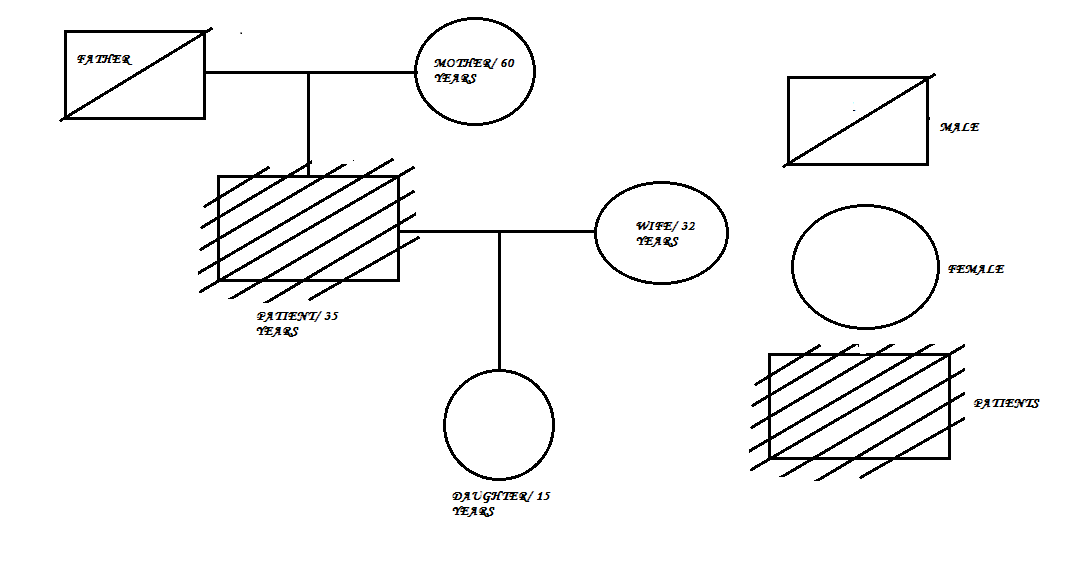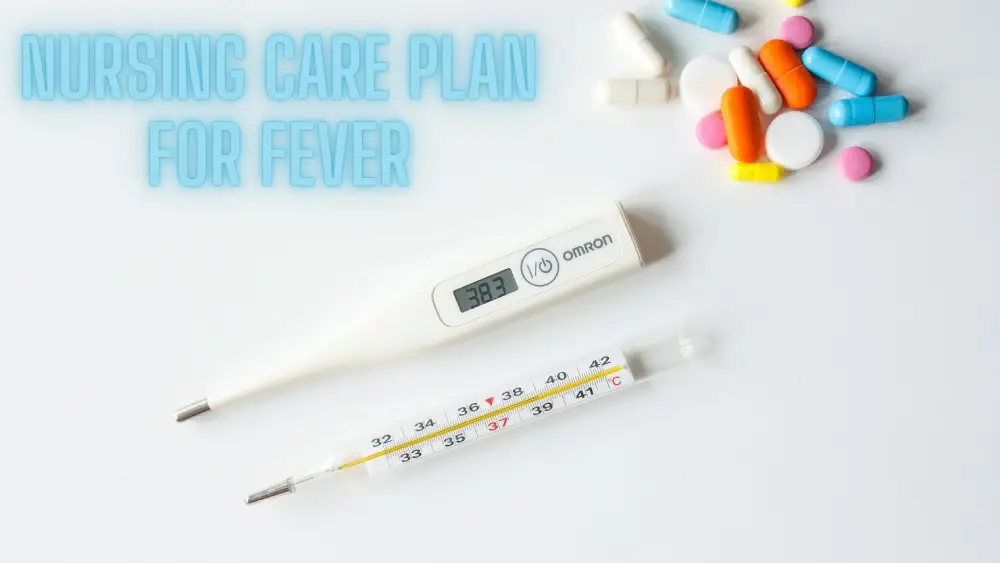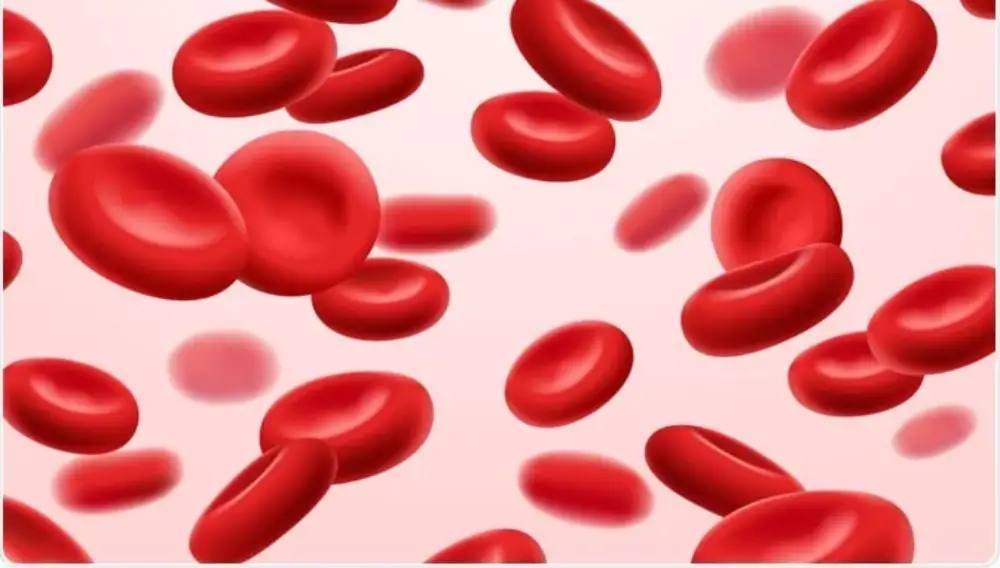Nursing Care Plan For Fever: A nursing care plan is a process that accurately identifies existing needs and recognizes a patient’s potential needs or risks. Therefore, it should be tailored to the patient’s specific needs, taking into account the patient’s medical history, current health status, and any underlying problems.
This nursing care plan guides you in providing care for patients with hyperthermia. Learn about nursing assessment, intervention, and nursing diagnosis to promote safe nursing care for pyrexia patients.
What is Hyperthermia and Fever?
Hyperthermia which is commonly known as a fever, is a medical condition characterized by an elevated body temperature beyond the normal range, usually greater than 39 °C (102.2 °F). It occurs when the body’s thermoregulation process (controls temperature) fails to maintain a balance between heat production and heat loss.
Why Nursing Care Plan For Fever?
Nursing care planning and diagnosis are essential for managing hyperthermia. Nurses play an important role in assessing and monitoring the patient’s body temperature, identifying the cause of fever, and implementing appropriate interventions to manage symptoms.
What are the Common Causes of Hyperthermia?
Hyperthermia or fever can be caused by various factors such as dehydration, excessive heat exposure, and certain drug reactions. Also, certain medical conditions such as infections, cancer, and autoimmune diseases can cause hyperthermia.
How Can Fever Affect a Patient’s Overall Health?
Hyperthermia or fever can impact on overall health of a patient. It can cause weakness, loss of appetite, fatigue, and dehydration. In some cases, it can lead to convulsions, delirium, and even coma.
What are the Symptoms of Hyperthermia?
There are some symptoms of hyperthermia which include sweating, headache, elevated body temperature, muscle aches, and chills.
Nursing Care Plan For Hyperthermia
A nursing care plan for a patient with a fever should include managing the fever itself, identifying and addressing the underlying cause, and providing medication to the patient. Here is a general outline for a nursing care plan for fever.
| Nursing Care Plan on Fever /Pyrexia / Hyperthermia | |
| BIOGRAPHIC DATA | |
| Name | Kamal Pasha |
| Address | Murshidabad, Berhampore |
| Gender | Male |
| Age | 35 Years |
| Marital Status | Married |
| Occupation | Teacher |
| Religion | Muslim |
| Education | Graduate |
| Nationality | Indian |
| Family Income | 2,00,000/- Per Annum |
| Word No./ Unit No. | 201 |
| Bed No | 12 |
| Date of Admission | 01st September 2023 |
| Diagnosis | Hyperthermia |
2) Chief Complaints
The patient says, “I have been suffering from a fever for 7 days and with having sensation in my eyes, body aches, and irritation”
3) History of Patient’s illness
My patient, Kamal Pasha, age 35 years has been suffering from Fever/Pyrexia/Hyperthermia for 7 days.
4) History of Patient’s illness
- Post Medical History: – No Post Medical History
- Post-Surgical History:- No Post-Surgical History
4) Medical History
- i) Present Medical History:- My patient has been suffering from a fever for 7 days and with having sensations in the eyes, body aches, and irritation.
- i) Present Surgical History:- No Present Surgical History
6) Family History
- He is the main owner of the house
- The family is pure vegetarian and eats a balanced diet during the day
- His mother and wife both are house-wife
- He has a girl child
6) Family Tree

7) Socio Economic Status
- Kamal Pasha is 35 years old married person
- He is a schoolteacher.
- His family is pure vegetarian and eats a balanced diet during the day
- His mother and wife, both are housewives
- His annual income is Rs.2,00,000
- The surrounding area of his house is clean and pollution-free.
- There is a proper supply of water and electricity at his house.
8) Personal History
- Kamal Pasha was well nourished before the pyrexia
- He used to handle his body with care, i.e. no hair loss problem, etc
- He was suffered from the insomnia problem
9) Nutritional History
- The family is a pure vegetarian
- He used not to take a well-balanced diet due to pyrexia
- He can take nutrition by intravenous drips like glucose, lactose, etc.
| GENERAL EXAMINATION | |
| General Appearance | |
| Nourishment | Under Nourished |
| Body Build | Healthy (According to BMI) |
| Health | Unhealthy (Due to Pyrexia) |
| Activity | Tired |
2) Mental Status
| Consciousness | Conscious |
| Look | Anxious |
3) Posture
| Body | Altered |
| Movement | Altered Body Movement |
| Height | 5.6” |
| Weight | 60 Kg |
4) Skin Condition
| Color | Pallor |
| Texture | Dryness |
| Temperature | Warm (103 F / 39.4 C) |
5) Head and Face
i) Head:-
| Cleanliness | Unclean Status |
| Hair Condition | Normal Hair Colour |
| Dandruff | No Evidence Found |
| Infections | No Evidence Found |
ii) Face:-
| Flushed | Yes |
| Puffiness | Yes |
| Fatigue | No |
| Pain | Yes |
| Anxiety | Yes |
iii) Eyes:-
| Eyebrows | Normal Black |
| Eyelashes | Normal |
| Eyelids | Dry |
| Eye Balls | Burning Sensation in the Eye |
| Conjunctiva | Pale |
| Cornea and Ins | Normal |
| Pupils | Normal Reaction to Light |
| Lens | Normal |
| Eye Muscles | Normal Working |
| Vision | Normal |
iv) Ears:-
| External Ear | Normal |
| Tympanic Membrane | Normal |
| Hearing | Normal |
v) Nose:-
| External Nose | Dry |
| Nostrils | Normal |
6) Mouth and Pharynx
| Lips | Skin Layer is Dry and Rough |
| Breath | Normal |
| Teeth | 32 in Number and Cavity Free |
| Mucus Membrane and Gums | Normal |
| Tongue | Normal |
| Throat and Pharynx | Sore Throat |
7) Neck
| Lymph Nodes | No Swelling Observed |
| Thyroid Gland | No Swelling Observed |
| Range of Motion | Normal |
7) Chest
| Shape | Normal |
| Symmetry | Normal |
| Posture | Normal |
| Breath Sound | Heart, Tachypnea |
| Heart | Palpation Feel, Pulse Rate (Tachycardia) |
| Size and Location | Appropriate Observed |
8) Abdomen
| Observation | Normal |
| Auscultation | Normal |
| Palpation | Normal |
| Percussion | Normal |
9) Extremities:- Weakly working/ Joint pain due to pyrexia
10) Back:- Backache
11) Genitalia and Rectum:- Normal
12) Neurological Test:-
| Co-Ordination Test | Altered Co-ordination |
| Equilibrium Test | Normal |
| INVESTIGATION | |
| Name | Kamal Pasha |
| Gender | Male |
| Age | 35 Years |
| Word No./ Unit No. | 201 |
| Bed No | 12 |
| Date of Admission | 01st September 2023 |
| Diagnosis | Hyperthermia |
| Time | 4:00 PM |
| Ref By | Dr Mohit Kumar |
| COMPLETE BLOOD COUNT (CBC) | ||
| Test | Patient Value | Normal Value |
| Hemoglobin | 11.8 | 12.0-15.0 (g/dl) |
| RBC (Red Blood Cell) | 3.7 | 3.8-4.8 |
| WBC (White Blood Cell) | 3560 | 4000-10000/cm |
| Platelet Count | 96000 | 150000-410000 |
| MCU | 89.6 | 83-101 |
| MCH | 30.2 | 27-32 pg |
| MCHC | 30.7 | 31.5-34.5 (g/dl) |
| Eosinophils | 01 | 0-7% |
| MEDICATION TABLE | ||
| Medication Name | Administration Type | Dose |
| Paracetamol | Oral | 500 mg |
| Ciprofloxacin | Oral | 250 mg |
5 Nursing Diagnosis on Hyperthermia
The nursing diagnosis of hyperthermia is based on the symptoms observed in the patient. It involves a systematic assessment of the patient’s body temperature, weakness, hydration status, and other vital symptoms. Here are some of the possible nursing diagnoses for hyperthermia in this nursing care plan for fever.
- Hyperthermia is associated with prolonged exposure to heat and dehydration, such as a body temperature of 38.5°C or higher.
- Prevent situations that can trigger body temperature fluctuations.
- Prevent cold complications.
- Risk of fluid deficit associated with excessive sweating and inadequate fluid intake, as evidenced by decreased urine output and dry mucous membranes.
- Risk of hyperthermia related to impaired thermoregulation due to a medical condition, such as evidenced by a history of heat-related illness or exposure to a hot environment.
Nursing Care Plan For Fever PDF Download
Do you want to download the pdf of Nursing Care Plan For Fever? – You can do so from the given link. From this pdf file, you will get the exact idea about the care plan. Here is the Nursing Care Plan PDF.
Conclusion
I hope ‘Nursing Care Plan for Fever’ will help you in your nursing project. If yes, then please share with your other friends as well.
Frequently Asked Questions (FAQs):-
01. What are the Symptoms of Hyperthermia?
Ans: There are some symptoms of hyperthermia which include sweating, headache, elevated body temperature, muscle aches, and chills.
02. How Can Fever Affect a Patient’s Overall Health?
Ans: It can cause weakness, loss of appetite, fatigue, and dehydration. In some cases, it can lead to convulsions, delirium, and even coma.
03. What are the Common Causes of Hyperthermia?
Ans: Hyperthermia or fever can be caused by various factors such as dehydration, excessive heat exposure, and certain drug reactions.
04. What is Hyperthermia and Fever?
Ans: Hyperthermia which is commonly known as a fever, is a medical condition characterized by an elevated body temperature beyond the normal range, usually greater than 39 °C (102.2 °F).
05. What are the 5 Nursing Plans?
Ans: These are assessment, diagnosis, planning, implementation, and evaluation.




